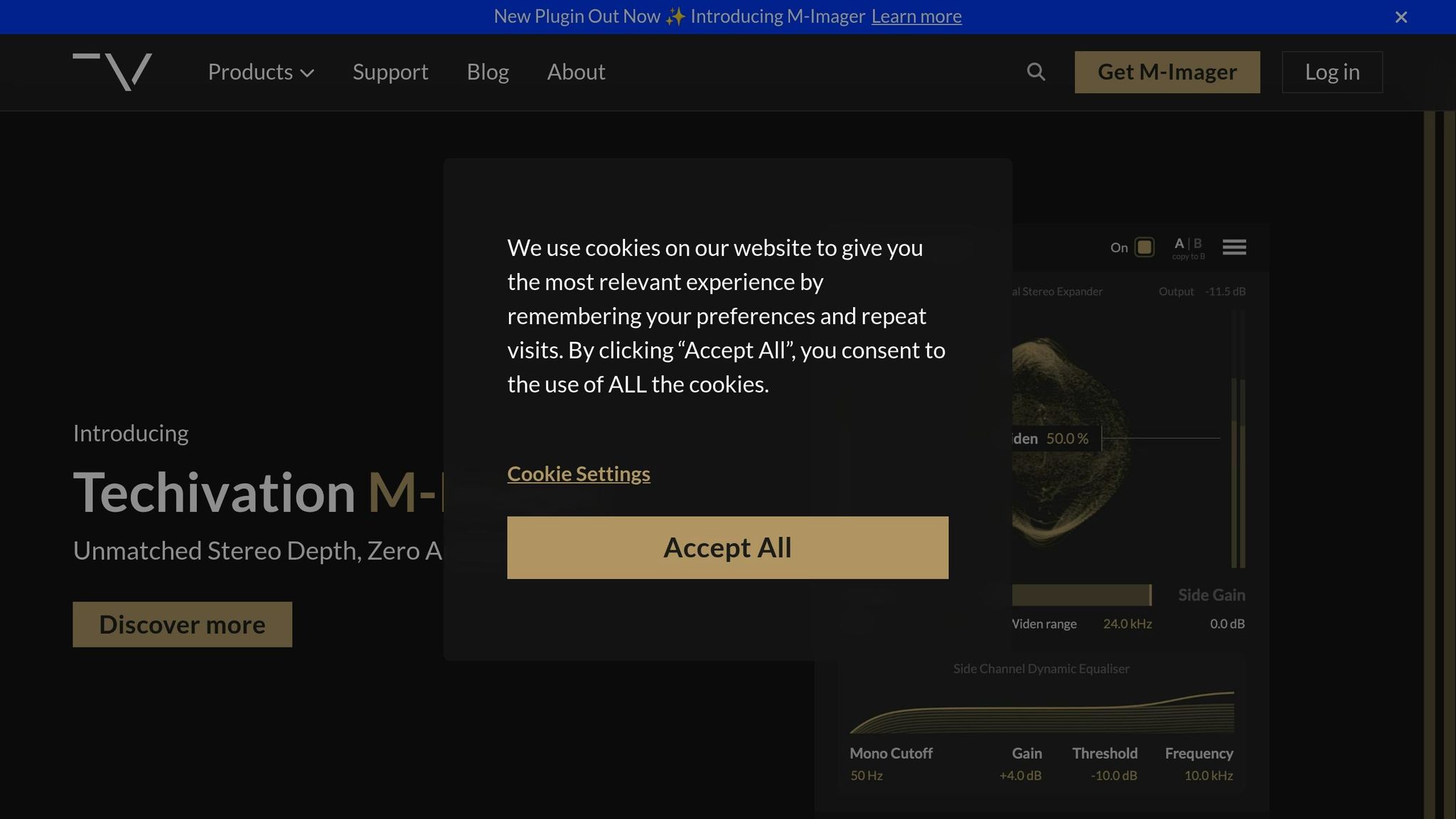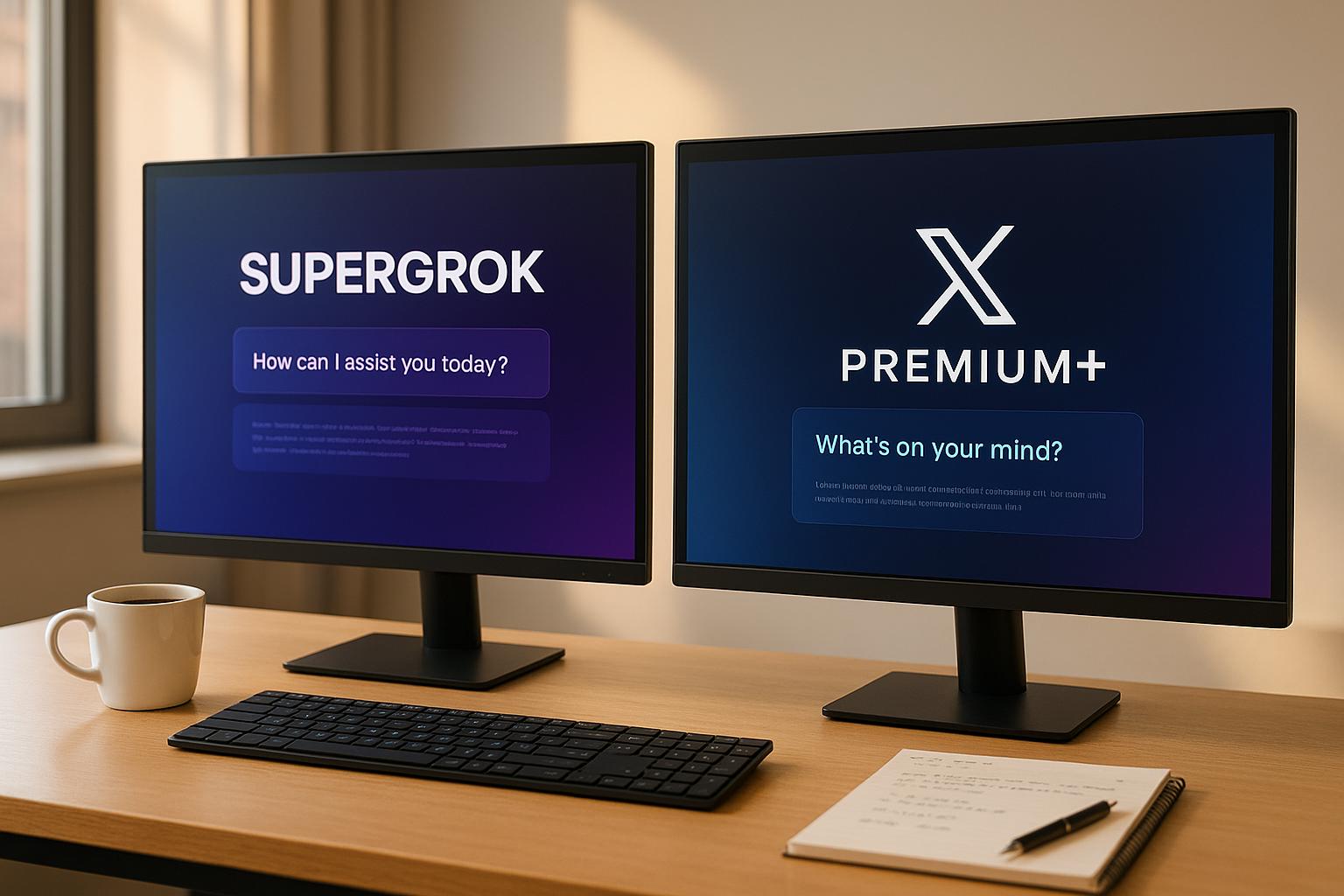AI compression tools are transforming how music producers manage audio dynamics. These tools automate tasks like adjusting attack, release, and ratio settings, saving time and simplifying workflows. They analyze audio signals in real time, making precise adjustments tailored to each track's needs. Whether you're fine-tuning vocals, drums, or mastering a mix, these tools ensure polished results.
Key takeaways:
- Automation: AI handles technical adjustments, letting producers focus on music.
- Customization: Tools adapt to various genres and styles.
- Ease of Use: User-friendly interfaces with presets make them accessible to beginners and experienced producers alike.
Popular tools include FabFilter Pro-C 2, Waves CLA-76, and iZotope Neutron 4, each offering unique features for different production needs. These tools are reshaping music production by combining efficiency with high-quality results.
AI-Compressor by Techivation – Game-Changing Dynamics Plugin?

Key Features of AI Compression Tools
Modern AI compression tools bring automation and ease to dynamic range control while still allowing producers to maintain creative freedom. Let’s dive into how features like automation, customization, and user-friendly design streamline the production process.
AI-Powered Automation
At the core of AI compression is its ability to analyze and respond to audio signals automatically, eliminating the need for constant manual adjustments. These tools use machine learning to evaluate signal peaks and RMS values in real time, pinpointing the optimal compression settings almost instantly. Instead of endlessly tweaking controls, producers can rely on the AI to establish a solid starting point for compression.
AI compressors handle attack, release, and ratio settings dynamically by processing signal peaks, frequency content, and overall dynamics. They make rapid decisions on aspects like compression ratios, knee settings, and even multi-band adjustments - all without interrupting the creative flow. This allows producers to focus more on the music and less on the technical fine-tuning.
Customization and Style Options
AI compression tools stand out for their ability to adapt to various musical styles and contexts. For example, they can differentiate between the subtle touch needed for a jazz piano and the bold compression required for a modern pop vocal. Genre-specific algorithms ensure that each track gets the treatment it needs.
These tools often come with style presets inspired by thousands of professional mixes. Whether you choose a "vintage tube" or "modern digital" preset, the AI applies not only unique compression curves but also harmonic tones, timing characteristics, and frequency adjustments that match the selected aesthetic.
Another standout feature is user preference learning. Over time, these tools learn from the adjustments producers make to their initial suggestions, evolving into a personalized assistant that aligns with each producer's unique sonic preferences. Additionally, many AI compressors use contextual processing, tailoring their approach based on the role of the track in the mix. For instance, lead vocals might get a different treatment than background harmonies, while bass compression adjusts depending on whether it’s anchoring a ballad or driving an upbeat dance track.
User-Friendly Design and Simple Operation
AI compression tools are designed with accessibility in mind, offering intuitive interfaces that cater to both beginners and experienced producers. Essential controls are prominently displayed, with advanced options tucked away in expandable sections. This ensures that newcomers can achieve polished results without feeling overwhelmed, while seasoned users can dive into more detailed adjustments.
Real-time visual feedback is another key feature. Tools like gain reduction meters, frequency analyzers, and waveform displays provide instant insights into how the AI is shaping the sound. Some even offer before-and-after visualizations, making it easier to grasp the impact of specific settings.
These tools also simplify complex techniques like multi-stage compression or parallel processing. Producers can apply intricate compression chains with just a few clicks and then tweak the intensity or tone as needed. For example, when you adjust attack times, the AI automatically recalibrates release times to preserve the rhythm, while threshold changes can trigger ratio adjustments to maintain the desired compression character.
Integration is seamless, too. AI compressors can automatically adapt to different sample rates, bit depths, and plugin formats, sparing producers from tedious setup tasks. This lets them focus entirely on the creative aspects of their work, making the production process smoother and more efficient.
Best AI Compression Tools for Music Producers
AI has transformed the way compression tools work, making life easier for music producers by simplifying their workflows.
Top Tools Overview
Today's AI-driven plugins are designed to analyze audio, adjust attack and release settings in real time, and adapt to the unique characteristics of different instruments. While each tool has its own approach, the goal is the same: to help producers achieve consistent, balanced mixes without spending hours on manual adjustments.
Let’s dive into the features, system requirements, and how these tools can be used in music production.
Features and System Requirements
AI-powered compression tools often come packed with:
- Smart automation that fine-tunes compression settings based on the audio input.
- Customizable, adaptive processing to suit individual tracks or instruments.
- Advanced lookahead functionality for smoother handling of transients.
To run these tools, you’ll typically need a 64-bit system with at least 8 GB of RAM. They’re compatible with VST, AU, and AAX formats, running on both the latest versions of Windows and macOS.
These features aren’t just about convenience - they can make a real difference in the studio.
Practical Applications in Music Production
AI compression tools shine in a variety of production scenarios, including:
- Vocal processing: Automatically adjusting compression settings to maintain clarity, whether it’s a soft verse or a powerful chorus.
- Drum tracks: Identifying and treating individual percussive elements to preserve punch and definition.
- Mix bus and mastering: Helping create a polished, balanced mix ready for release.
- Home studios: Compensating for less-than-ideal acoustics by tackling room-related imbalances, making it easier to achieve professional-quality results with minimal effort.
These tools are reshaping the way producers approach mixing and mastering, offering smarter solutions for both seasoned professionals and home studio enthusiasts.
sbb-itb-212c9ea
AI Compression Tools Comparison: Features, Pros, and Cons
Picking the right AI compression tool can make a big difference in your production workflow. Each tool has its own set of features, strengths, and limitations. Knowing these details can help you choose the best fit for your studio setup. Here’s a quick comparison of some of the top options.
Feature Comparison Table
| Tool | Key Features | Format Support | Best For |
|---|---|---|---|
| FabFilter Pro-C 2 | Adaptive release control, adjustable compression knee | VST, AU, AAX | Versatile mixing and mastering |
| Waves CLA-76 | Digital emulation of the classic 1176, automated attack control | VST, AU, AAX | Enhancing vocals and drums |
| iZotope Neutron 4 | AI-powered Mix Assistant, advanced track enhancement | VST, AU, AAX | Comprehensive mix processing |
| Universal Audio 1176 | Authentic analog emulation, precision presets | VST, AU, AAX | Classic analog sound |
| Slate Digital FG-X | Transparent limiting, preserves dynamic punch | VST, AU, AAX | Mastering applications |
Pros and Cons of Popular Tools
Let’s break down what makes each tool shine - and where they might fall short.
FabFilter Pro-C 2
This tool offers exceptional visual feedback and precise control, making it a favorite for those who want detailed adjustments. However, its extensive features can feel overwhelming for beginners, and it’s priced on the higher end.
Waves CLA-76
If you’re after the classic 1176 sound, this is a go-to option. It adds warmth and character, especially to vocals and bass. That said, its specialized design means it’s not the most versatile choice for all compression needs.
iZotope Neutron 4
The standout feature here is the AI-powered Mix Assistant, which analyzes your mix and suggests compression settings. It’s a lifesaver for complex projects, but the higher CPU demand and steeper learning curve might be a challenge for new users.
Universal Audio 1176
Known for its authentic analog emulation, this tool delivers precision and a vintage sound that many producers love. However, to get the most out of it, you might need specific hardware configurations, which could limit its accessibility.
Slate Digital FG-X
Perfect for mastering, this tool provides transparent limiting that keeps your mix punchy while optimizing loudness. It’s not designed for everyday compression tasks but excels during final mix processing.
Your choice will depend on your production style, project complexity, and specific workflow needs. For more tools and insights, visit AI Apps.
Adding AI Compression Tools to Your Production Workflow
Incorporating AI compression tools into your production process can make life a lot easier. These tools aren’t here to replace human engineers - they’re here to take care of repetitive tasks and give you a strong starting point for mixing and mastering. Here’s how you can make AI compression tools work for you:
Integrating AI Compression Tools into Your Workflow
Bringing AI tools into your workflow involves three key steps:
-
Prepare Your Audio
Start with high-quality WAV files and ensure proper gain staging. This step is crucial because clean, well-prepped audio allows AI tools to deliver accurate results when controlling dynamics. -
Let the AI Analyze
Use the AI to evaluate your track and set up initial levels and EQ. Many AI compressors come with presets tailored to specific genres, giving you a head start on achieving the ideal dynamic range. -
Fine-Tune the Settings
After the AI has done its job, it’s time to step in and make adjustments. Use your ears to tweak the settings and ensure the mix aligns with your creative vision. This final step is where you bring the balance and dynamics to life, turning the AI’s suggestions into a polished, professional mix.
The Future of AI in Music Compression
AI-driven compression technology is reshaping the way music producers manage dynamic range control, offering tools that simplify and enhance the production process. While today’s solutions are impressive, the advancements on the horizon promise to take intelligent audio processing to new heights. Let’s dive into the key benefits and the trends shaping the future of AI compression.
Main Benefits of AI Compression Tools
AI compression tools have become a game-changer for studios, offering both time-saving efficiency and consistency. Tasks that once required hours of manual adjustments can now be completed in minutes. These tools analyze audio content and automatically apply compression settings, removing the trial-and-error process that often slows down mixing.
Another standout advantage is consistent quality across projects. Whether you're working on one track or an entire album, AI compression tools deliver uniform results. This is especially valuable during long sessions when fatigue might otherwise impact decision-making. Producers can rely on these tools to maintain professional standards, even under tight deadlines.
For those new to music production, the reduction in the learning curve is invaluable. AI simplifies complex settings, allowing beginners to achieve polished compression without needing deep technical knowledge. This lets producers concentrate on the creative aspects while the AI handles the technical heavy lifting.
Modern AI compressors also adapt to different genres, tailoring compression to suit specific styles. For instance, they can distinguish between the subtleties of jazz vocals and the intensity of heavy metal drums, applying compression that complements each genre’s unique dynamics.
Upcoming Trends in AI Audio Processing
Building on these benefits, the next wave of AI compression tools is set to offer even greater control and integration. One of the most exciting developments is real-time adaptive processing, where compressors adjust dynamically as a track plays, responding to the music’s evolving context and energy.
Another trend to watch is multi-band AI processing, which will allow for precise frequency-specific compression across the audio spectrum. This means AI can independently manage different frequency bands, adding a level of nuance and detail to the mix.
Collaborative AI systems are also on the horizon. These systems will enable multiple AI tools, such as compressors and EQ plugins, to communicate and make coordinated decisions. For example, a compressor could adjust its settings in sync with an EQ to ensure both dynamics and tonal balance are optimized together.
The integration of machine learning based on user preferences is another promising development. Future AI tools will learn from a producer’s past decisions, gradually tailoring their suggestions to match individual creative styles and preferences.
Finally, improvements in cross-platform compatibility will make it easier to use AI tools across various digital audio workstations (DAWs) and operating systems. This will lower technical barriers and expand access to these technologies for producers working in different environments.
As AI algorithms grow more sophisticated and processing power continues to advance, these tools will handle increasingly complex audio challenges. At the same time, they’ll maintain the simplicity and ease of use that make them so appealing. These innovations will further empower music producers, blending advanced automation with creative freedom, ensuring technical precision supports - not stifles - their artistic vision.
FAQs
How can AI compression tools improve the workflow of music producers compared to traditional techniques?
AI-powered compression tools are transforming the way music producers work by automating tasks like dynamic range compression, beat detection, and improving audio quality. These tools operate with impressive speed and precision compared to traditional methods, shaving off hours from the mixing and mastering process.
By handling repetitive and time-consuming chores, AI frees up producers to concentrate on the creative side of their projects. For beginners, these tools lower the barrier to entry, enabling them to produce professional-grade music without needing deep technical knowledge. Meanwhile, experienced producers can use AI to break through creative slumps and explore fresh ideas, pushing the boundaries of their sound.
How can AI compression tools adjust to different types of music genres?
AI compression tools are designed to adjust their settings based on the distinct traits of different music genres. For example, they can amplify punch and clarity in high-energy styles like EDM or hip-hop, while preserving the nuanced dynamics that are so crucial to jazz and classical pieces.
Beyond just fine-tuning, these tools unlock creative opportunities by enabling producers to experiment with genre-bending transformations. This means a track can be reshaped to fit an entirely different musical style. For producers juggling multiple genres, this adaptability is a game-changer.
What factors should music producers consider when selecting an AI compression tool for their studio?
When picking an AI compression tool, music producers should focus on compatibility with their Digital Audio Workstation (DAW). Make sure the tool works with formats like VST3, AU, or AAX and aligns with your system's hardware and software specifications.
Another important factor is the ease of use. Check if the tool offers features that match your workflow, such as dynamic range control or automation options. Opt for tools that deliver transparent processing and can adapt as your projects grow. It's also crucial to verify that the software includes strong data privacy and security features to keep your work safe.
By keeping these considerations in mind, you can find a tool that fits seamlessly into your studio setup while elevating your music production process.



